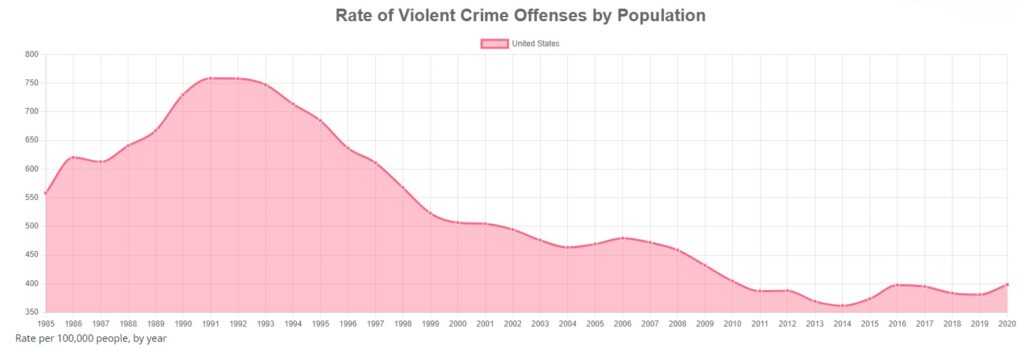Does it feel like violent crime has been on the rise in Chapel Hill and Carrboro?
According to a newly released report, it has been — at least in the last couple years. But it’s all in how you look at it: the same report also finds that today’s violent crime rate is far lower than it’s been in the past, both locally and nationwide.
The report in question is from the Federal Bureau of Investigation, using data submitted by local law enforcement agencies. These annual FBI reports can be used to track crime rates, not just from year to year, but across many years, even decades.
This year’s report drew mixed reviews from observers, because the FBI had to rely more heavily on estimates to determine the national crime rate. That’s because the FBI switched to a new data-collection system, one that required more effort from law enforcement agencies — and as a result, the FBI received data from only 66 percent of law enforcement agencies nationwide, down from about 90 percent in previous years. (Orange County’s law enforcement agencies, though, did submit their data for the year.)
Click here to see the data from 2021 and previous years, searchable by state and municipality.
In Chapel Hill, the study found an 18 percent increase in violent crimes in 2021, from 93 reported incidents to 110, the second-highest total since 2009. In Carrboro the increase was even larger: a 50 percent increase, from 46 incidents in 2020 to 69 last year. That’s the largest number of violent crimes Carrboro has experienced since 2008. (Durham, by contrast, actually saw a 12 percent decrease in violent crime in 2021.)
But while Chapel Hill and Carrboro saw an increase in crime in 2021, today’s violent crime rate remains far lower than it was less than a generation ago.
In both towns, crime totals were very high through the 1990s and early 2000s, before a sharp decline (most noticeable in Chapel Hill) that began around 2007 and has persisted to this day. Between 1990 and 2006, Chapel Hill averaged more than 240 violent crime reports a year — more than twice as many as the town experienced during the ‘spike’ of 2021.
These charts show the raw number of violent crimes reported each year, not the per capita crime rate – so the decline over time is actually more remarkable given that both towns have seen their populations increase over this period. (In contrast to the towns, the Orange County Sheriff’s Office reports more violent crimes today than it did in the 1990s – though that too is largely a function of increased population, rather than a higher per-capita crime rate.)

The above chart depicts the violent crime rate (per capita) across the state of North Carolina. As in Orange County, North Carolina’s crime rate is higher today than it was a couple years ago, but still far lower than it was 15 years ago. (Chart via the FBI’s Crime Data Explorer.)
That local trend is also present at the national level. In the early 1990s, the U.S. violent crime rate (per 100,000 population) peaked at more than 750 a year, the result of a steady, decades-long increase that began in the mid-1960s. Beginning in 1993, though, the crime rate began to drop just as steadily, until by 2011 it dropped below 400 for the first time since 1971.
View a chart of the U.S. violent crime rate by year, from 1960-2019.
Since then, the U.S. crime rate has remained mostly steady, fluctuating between 350 and 400 per year. In 2020, the U.S. saw a violent crime rate of 398.5 per 100,000 residents – technically the nation’s highest rate since 2010, but only by a small margin, and still far below the peaks of the early 1990s. (And though data for the year is limited, the FBI estimates that the violent crime rate dropped slightly in 2021.) America’s violent crime rate today is virtually unchanged from what it was 50 years ago, in 1972.
This reality is at odds with public opinion, and has been for years. Surveys have consistently found that a large percentage of Americans believe violent crime is on the rise in the U.S. — even when violent crime is sharply declining.
There is one notable dark side to the national picture, though: while the violent crime rate hasn’t changed much, the U.S. murder rate has spiked in the last two years. After holding steady for more than a decade at roughly 5.0 per 100,000 residents each year, the murder rate in 2020 jumped to 6.7 per 100,000, the highest rate since 1997 — and the FBI estimates the murder rate in 2021 was similar.
Chart images via the FBI’s Crime Data Explorer.
Chapelboro.com does not charge subscription fees, and you can directly support our efforts in local journalism here. Want more of what you see on Chapelboro? Let us bring free local news and community information to you by signing up for our biweekly newsletter.











